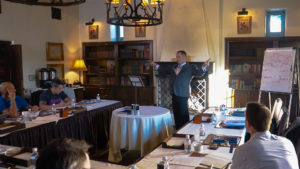LinkedIn is a professional networking site with over 800 million members. It has become the go-to platform for today’s professionals in virtually every industry and the platform can present some unique challenges when it comes to communicating effectively on LinkedIn.
From creating a public profile that sells your skills and professional accomplishments to staying up-to-date on relevant groups, LinkedIn is a powerful platform for professionals to network. The platform helps you reach out to new people, generate leads, and find business opportunities.
Effective communication can be a challenge in any context which requires interaction between two or more people from different backgrounds. These challenges are compounded when you consider the global nature of LinkedIn that spans a wide variety of beliefs, languages, and behaviors.
Today, we’ll dive into ten ways to communicate effectively on LinkedIn and discuss what effective communication is in practice — and what it’s not.
Be Clear and Brief
You can include as much information as you want on LinkedIn, but people won’t read it if they don’t think it’s relevant.
Use the first three words of each sentence to make your point clearly and concisely. Think of what you’re saying like a newspaper headline; the goal is to entice someone (who may not be your friend) to click on your article or engage with your content.
Brief writing keeps people reading. Make sure you focus only on the points that are most important for success.
Personalize your Message to Each Individual
Even though LinkedIn is a professional tool, it’s also a great place to network and make connections. People on LinkedIn do not always think of it as a networking platform, but it can be an extremely effective way to socialize with your peers and colleagues. Make sure to use this fact in your communication. Direct Messages are a fantastic way to reach out to someone since they’re personable and private.
Use direct messages and inMail cautiously, though. Nothing hinders your chances at making a real connection with your audience than impersonal messaging. Whenever possible, be sure to personalize your messages to each individual.
A few ways to personalize your messaging include:
- Using your contact’s name
- Referencing one of their recent achievements
- Mentioning one of their posts that you found impactful
A good rule of thumb is to communicate with your contacts on LinkedIn as you would at an in-person networking event.
Reply to Any Personal Messages Within a Few Days
When you are contacted personally on LinkedIn, it’s important to reply within a few days. Responding in less than 24 hours shows that you are active and interested in maintaining your network with the sender. While some people like to get caught up in their work, remember that LinkedIn is all about building relationships through networking.
Neglecting to respond can make someone feel ignored or snubbed, which could damage your relationship with them. If you get busy, try sending a quick message thanking them for reaching out, and stating when you will be able to get back to them. This way, they know that you received their message and are looking forward to talking with them further.
Group Discussions
You may have thought that LinkedIn was all about following other users, posting status updates, and adding people to your network. But did you know that it’s also a great place to connect with others in discussions around topics relevant to your industry?
One way to do this is by joining groups associated with your career interests. For example, if you are trying to connect with other professionals in the digital marketing field, join the group Digital Marketing Network. Post valuable comments on threads so that other users will see what value you have added and invite them to contact you outside of LinkedIn for more information about your services.
Ask for Advice
If you’re looking to establish yourself as an authority in your industry, there’s no better way than to ask for advice.
It may seem counterintuitive. After all, you’re supposed to be the expert, right? Still, when it comes to engaging with your audience on LinkedIn, nothing gets the conversation going like inviting your audience to share their own expertise.
You can invite people to contribute their thoughts and ideas on a specific topic by posting a question to either your status update or your group. When you post this question, be sure that it’s open-ended. A good example might be “What’s the best way for ____ company to _____?”. These kinds of questions help the conversation flow naturally.
Give and Receive Recommendations
Recommendations are a fantastic way to enhance your LinkedIn profile with relevant credentials. Also, recommendations are often viewed as more trustworthy than what you might say about yourself in an “About Me” section or an article summary.
Prior to asking for recommendations, be sure to have at least five completed recommendations on your profile already. It’s also important to provide context about why you’re asking for a recommendation, and how they can help you by taking the time to complete your request. If your request appears disingenuous or just out of the blue, it’ll likely go ignored.
Giving recommendations — solicited or unsolicited — is also a great way to expand your network and your visibility on LinkedIn. Every time a recommendation you’ve written is published on a contact’s profile, your information appears alongside it, making it that much easier for additional contacts to find and engage with you.
Create Engaging Content
What you share on LinkedIn is just as important as how you interact with your audience. After all, sharing relevant, engaging content will help you to increase your visibility and bolster your relationship with your target market.
Your strategy should go beyond creating a constant stream of interesting articles, blog posts, videos, and presentations that are specific to your industry or niche. It should be driven by a strategy that is designed to amplify your voice and make you a part of the conversations that matter.
A great way to do this is to follow this four-step process at least a few times each week:
- Take a look at what the thought leaders in your space are sharing. Notice the hashtags they are using.
- Click on those hashtags and review some of the most engaging posts. Spend at least a few minutes each day commenting on some of your favorites.
- Pick one that you find particularly interesting, and re-share it to your own profile, adding your own thoughts and insights in the caption.
- Don’t forget to add even more relevant hashtags before you hit “publish.”
You can also use the most engaging content in the list to inform your decisions when it comes to planning out your own original content. By taking this simple four-step approach, you can be sure you’re sharing and creating content that you already know will resonate with your target audience.
Boost Your Organization’s Profile
If you’d like to take your LinkedIn presence up a notch, consider creating a business page. Business pages offer all the same functionality as personal profiles but are customized for businesses and brands.
By providing links to articles, blogs, videos, etc., companies are able to share engaging content with their target market while also providing valuable information that helps to position them as an expert in their particular field of business. It’s also a great way to drive traffic to your business website.
One thing you may notice, however, is that the content you share on your business page doesn’t get as much engagement as the content you share on your personal profile. This is to be expected. After all, LinkedIn is, at its core, a networking site.
Not to worry. Try this easy tip for helping the content on your business page spread far and wide:
First, make sure that both you and your team are active on LinkedIn and that everyone is connected to your business page. Each time you share new content to your page, you will be given the option of notifying your employees that new content has been published. That way, they will be able to share the new post to their own profiles and help your content reach a wider audience. Make sure you do the same! Don’t simply hit share and forget about it. Add your own thoughts to the caption, and be sure to follow up with your posts to reply to any comments.
Observe Professional Etiquette
The more you connect with others, the more opportunities you’ll have to build relationships that may end up serving you in some way down the line.
This doesn’t mean that things like email etiquette and other rules of professional conduct no longer apply. Be sure to follow these guidelines when communicating via LinkedIn:
Don’t be overly self-promotional
It’s perfectly acceptable to promote yourself and your business but do so in moderation. Share interesting posts or articles related to your industry, share relevant content created by others (as explained above).
Keep it Professional
LinkedIn is not the place for divisive or controversial content (unless, of course, it’s specifically relevant to your industry). It’s also not the place for keyboard warriors. In general, keep your tone and content professional. Don’t say anything on LinkedIn that you wouldn’t say to your coworker in person.
Be a Good Steward of Your Audience
You will undoubtedly increase your own “know-like-trust factor” if you’re a good steward of your audience. That means helping them reach their goals and asking what you can do for them. Introduce them to relevant contacts, help them make connections, and engage with their content to keep the conversation flowing.
Conclusion
We’ve covered a lot of ground regarding how to use LinkedIn as an essential part of your professional life. There are many different ways for you to connect with colleagues and clients — through direct messages, group conversations, or by participating in the discussions that matter most to you.
The internet has changed the way we communicate, but it’s still possible to have an effective conversation online. A little effort in developing effective communication skills can go a long way towards helping you have a positive impact on your audience, and in turn, your business.
Taking the time to craft a strategy, recruit the right resources, and implement effectively can yield tremendous results. To meet and learn more about elevating your LinkedIn presence, schedule a 15-minute Meet & Greet with Ken Kilday.




